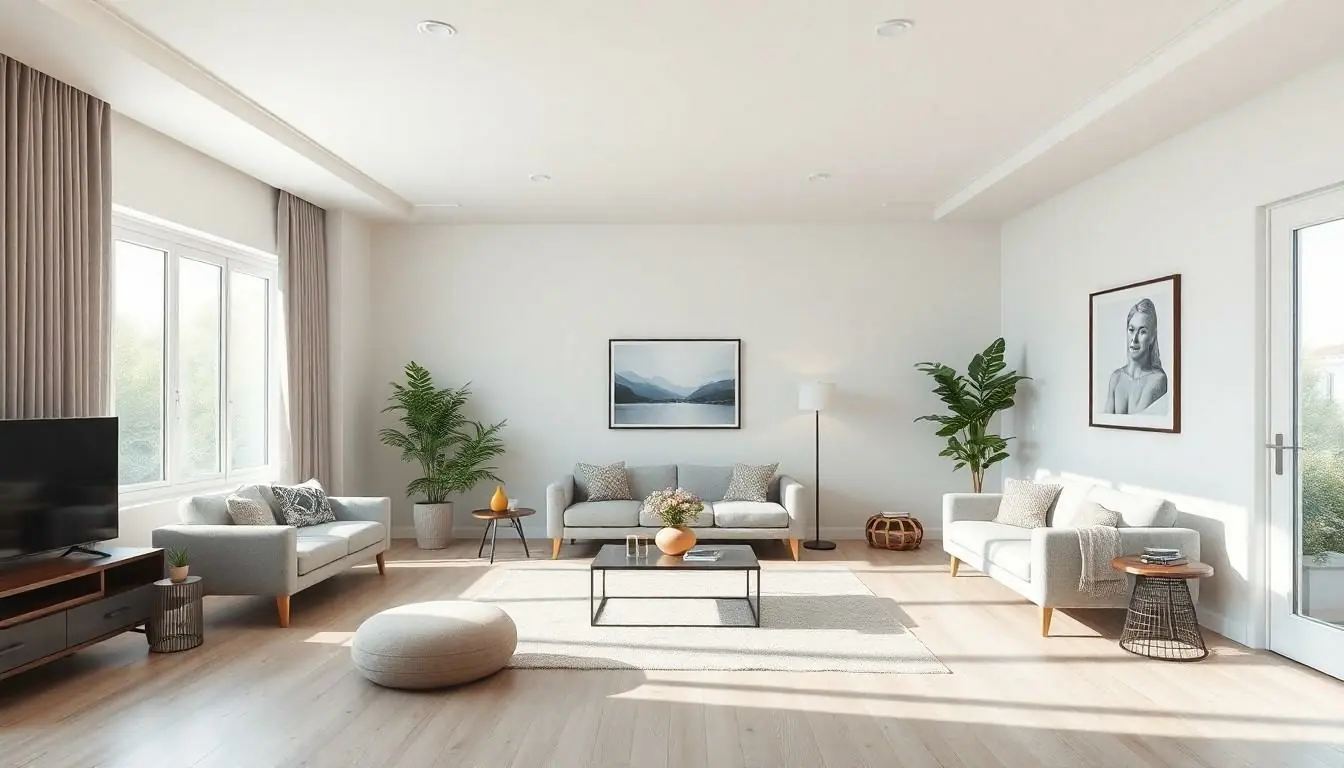In a world filled with chaos and clutter, the minimalist living room emerges as a serene oasis. Imagine stepping into a space where every piece of furniture serves a purpose, and the only thing competing for your attention is that cozy throw blanket. Minimalist interior design isn’t just a trend—it’s a lifestyle choice that promotes tranquility and intentionality.
Gone are the days of juggling too many decor items like a circus performer. Instead, embrace the beauty of simplicity and let your living room breathe. With clean lines and a few carefully chosen pieces, you can create an inviting atmosphere that whispers relaxation. So grab a cup of tea and get ready to discover how to transform your living room into a minimalist masterpiece that even Marie Kondo would applaud.
Table of Contents
ToggleWhat Is Living Room Minimalist Interior Design?
Living room minimalist interior design focuses on simplicity and functionality. This style prioritizes essential elements, emphasizing open space and light. Key features include neutral color palettes, clean lines, and uncluttered surfaces. Furniture serves a functional purpose while maintaining an aesthetically pleasing appearance.
A minimalist living room often incorporates fewer pieces, providing more room for movement and relaxation. Each item plays a significant role, contributing to the overall ambiance without overwhelming the senses. Natural materials are prominent, such as wood and stone, which bring warmth and texture to the space.
Decorative elements in minimalist design remain limited but intentional. Select accessories enhance the environment without creating clutter. Plants often serve as focal points, adding life and color while maintaining the clean and serene atmosphere.
Lighting holds importance in this design approach. Natural light becomes a vital element, with large windows or strategically placed mirrors reflecting brightness throughout the room. Artificial lighting, when used, should be simple yet effective, avoiding overly ornate fixtures.
In essence, living room minimalist interior design champions a lifestyle of clarity and purpose. It encourages individuals to surround themselves only with what matters most, fostering an environment conducive to relaxation and mindfulness. This approach transforms the living room into a sanctuary, providing a restorative space in an otherwise chaotic world.
Key Principles of Minimalist Design

Minimalist design focuses on creating peace and functionality in living spaces. Prioritization of simplicity is essential.
Simplicity and Functionality
Simplicity stands at the forefront of minimalist design. Furniture should fulfill dual roles, serving both practical and aesthetic needs. Choosing essential pieces avoids overwhelming the space. Thoughtful selection reduces visual clutter while enhancing usability. Each item must contribute to the overall harmony and balance of the room.
Neutral Color Palette
Neutral color palettes create a calming backdrop in minimalist interiors. Shades like white, beige, or gray promote light and openness. These colors help to enlarge the perceived space and allow natural light to reflect. Adding subtle accents can personalize the environment without detracting from the minimalist ethos. A cohesive color scheme supports the serene atmosphere essential to minimalist design.
Decluttering Essentials
Decluttering remains crucial in minimalist living rooms. Removing excess items fosters an organized and tranquil space. Focus on keeping only what actively contributes to the room’s function or aesthetic. Storage solutions should be sleek and unobtrusive, ensuring easy access to essentials. Regularly reassessing belongings encourages a lifestyle that values simplicity and intentionality, reinforcing the minimalist approach.
Benefits of Living Room Minimalist Interior Design
Living room minimalist interior design offers numerous benefits that enhance both aesthetics and well-being.
Enhanced Space Perception
In minimalist living rooms, open spaces create an airy feel. Fewer furniture items allow for easier navigation. Large windows promote light, further enhancing the perception of spaciousness. This design approach often incorporates neutral colors that contribute to a bright atmosphere. Wide, uncluttered surfaces prevent overcrowding and promote a serene environment. Visual harmony emerges from clean lines and streamlined furniture, providing a sense of order. Clarity in design ensures that each element serves a purpose, minimizing distractions. Adding a few well-placed decorative items can elevate the visual appeal without overwhelming the space.
Stress Reduction
Stress reduction becomes a priority in minimalist interiors. An uncluttered environment promotes mental clarity and relaxation. Simplicity encourages individuals to focus on what truly matters, enhancing peace of mind. Neutral tones provide a calming backdrop that reduces visual noise. Functional furniture minimizes the chaos often associated with excess items. Incorporating natural materials like wood or stone can evoke tranquility. Intentional decorative elements, such as plants, introduce a soothing connection to nature. This lifestyle fosters mindfulness, creating a restorative retreat amid daily pressures.
How to Achieve a Minimalist Living Room
Achieving a minimalist living room requires careful consideration of design elements and intentional choices. Focus on essential components that enhance simplicity and functionality.
Furniture Selection
Select furniture with clean lines and a neutral palette. Prioritize multi-functional pieces that serve dual purposes. For example, choose a coffee table with hidden storage to minimize clutter. Consider a sofa that incorporates storage for blankets or cushions. Limit the number of furniture pieces to maintain open space, which creates a more airy atmosphere. Avoid oversized items that dominate the room or distract from the minimalist aesthetic. Incorporate natural materials, like wood and linen, to add warmth and texture to the space. Create a harmonious balance by ensuring all selections complement each other.
Accessorizing Wisely
Incorporate accessories that enhance the serene environment without overwhelming it. Choose a few accent pieces that reflect personal style while maintaining simplicity. Plants are excellent choices, providing life and color without excessive visual clutter. Consider using minimalist artwork that adds character yet does not dominate the walls. Select light fixtures that blend seamlessly into the overall design, focusing on simple forms. Use textiles sparingly, opting for a few strategically placed cushions or throws to maintain comfort. Regularly reassess accessories and remove items that no longer serve a purpose or contribute to the tranquil ambiance.
Common Mistakes to Avoid
Avoid overcrowding the space with excessive furniture. Select only essential pieces that serve a purpose to maintain a tranquil atmosphere. Clutter detracts from the minimalist ethos, so regularly assess belongings and eliminate items that don’t enhance the living room.
Neglecting natural light is another common mistake. Maximize window usage and choose sheer curtains to invite brightness into the space. Artificial lighting should remain simple; intricate fixtures can distract from the minimalist aesthetic.
Using a mismatched color palette disrupts the calming environment. Stick to neutral shades such as white, beige, or gray, which promote tranquility and openness. Accent colors can be introduced sparingly, ensuring they blend well with the overall scheme.
Selecting decorative items without purpose can clutter the space visually. Curate a few intentional pieces that reflect personal style while complementing the minimalist design. Limit decorative elements to plants and minimal artwork to keep the focus clear.
Incorporating bulky storage solutions also leads to chaos. Opt for sleek, multi-functional furniture that provides storage without overwhelming the room. This choice emphasizes simplicity and maximizes space efficiency.
Ignoring furniture scale creates visual imbalance. Choose appropriately sized items that fit the proportions of the room, allowing for fluid movement and openness. Spaciousness should remain a priority, enhancing both comfort and aesthetics.
Finally, underestimating the impact of textiles can detract from the soothing ambiance. Use textiles sparingly, focusing on quality over quantity. Choose comfort-driven pieces that align with the minimalism of the design, ensuring they enhance rather than clutter the space.
Embracing minimalist interior design in the living room transforms the space into a calming sanctuary. By prioritizing simplicity and functionality, individuals can create an inviting atmosphere that promotes relaxation and mindfulness. Thoughtful choices in furniture and decor not only enhance the aesthetic but also support a lifestyle focused on clarity and purpose.
With an emphasis on natural materials and intentional decorative elements, this design approach fosters a sense of peace amidst daily chaos. Regularly reassessing belongings and maintaining an organized environment reinforces the benefits of minimalism. Ultimately, a minimalist living room serves as a restorative retreat that encourages individuals to focus on what truly matters in their lives.



